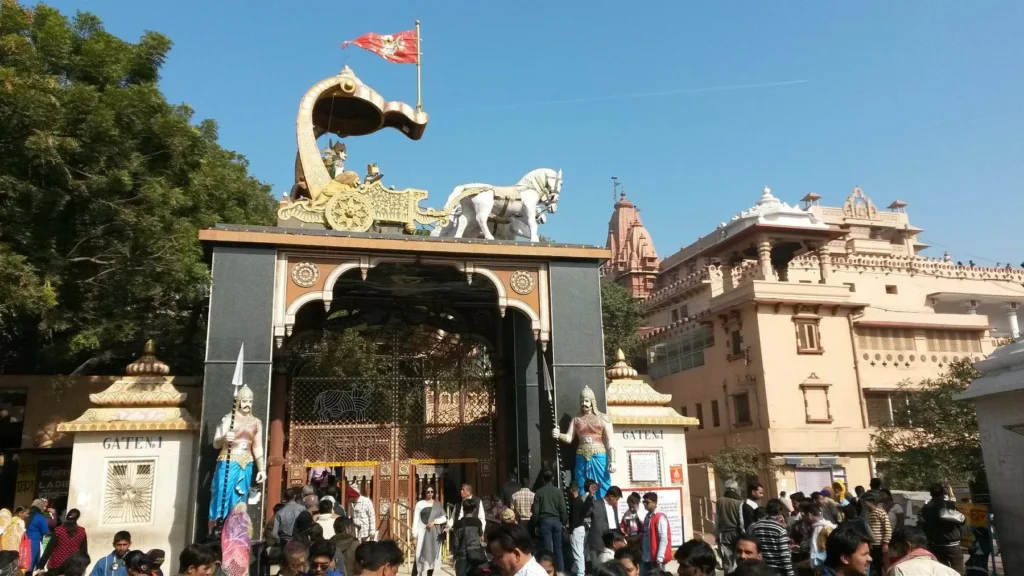Places And Temples to visit in Vrindavan

Vrindavan, the childhood home of Lord Krishna, is a popular place for pilgrims. It lies on a bend of the Yamuna River in the holy land of Braj Bhoomi. The name “Vrindavan” comes from two words—vrinda, which means tulsi (holy basil), and van, which means forest. Long ago, the area was full of tulsi trees.
Vrindavan is just about two hours by car from Delhi and only seven miles from Mathura, where Krishna was born. This town is full of stories from Krishna’s childhood, called leelas. One of the most famous is the raas leela—a joyful dance with Radha and the gopis (village girls). Many people believe this divine dance still happens every night in Nidhivan Kunj and Seva Kunj, two small groves where tulsi trees still grow.
Vrindavan is close to Mathura and sits on the land where Krishna once played with his friends, cows, and Radha. The town has a peaceful and spiritual feel. As you walk through its narrow lanes, you’ll find many temples dedicated to Radha and Krishna, each with its own story.
Just like the peda (a sweet from Mathura) pleases the tongue, the words “Radhe Radhe” fill the heart in Vrindavan. It is truly one of North India’s most loved holy places, where visitors come to feel peace and connect with the divine.
Now, let’s explore some of the famous temples in Vrindavan:
Banke Bihari Temple

Built in 1864, the Banke Bihari Temple is one of the most visited and loved temples in Vrindavan. The name Banke means “bent in three places,” and Bihari means “the supreme enjoyer”—a name for Lord Krishna.
The main attraction of the temple is the beautiful black idol of Lord Krishna. It is said that this idol is not just a statue, but a divine image left behind by Krishna himself after he appeared in front of his great devotee, Swami Haridas. Many visitors feel a deep connection and peace when they see the idol, making this temple truly special.
Prem Mandir

Prem Mandir is a stunning white marble temple in Vrindavan, built by the saint Jagadguru Shri Kripalu Ji Maharaj. Made entirely of Italian marble, it shines with beauty and devotion. The temple’s walls are decorated with detailed carvings showing the pastimes of Radha and Krishna. Visitors can walk around the temple to view 48 beautiful panels. At night, colorful lights and a dancing water fountain add to its magical charm.
Nidhivan

Nidhivan means “Treasure Forest”—and it truly is a mysterious and sacred part of Vrindavan. The trees here are short and twisted in strange shapes, adding to its magical feel. Many believe that every night, Lord Krishna still performs the Raas Leela with Radha and the gopis, and some say they even hear the sound of anklets (ghunghroos) echoing through the night.
This is a deeply spiritual place for Hindu worship. It is also where the divine image of Bihariji (Lord Krishna) was revealed to Swami Haridas Ji, one of his great devotees.
Seva Kunj

Seva Kunj is placed in the heart of Vrindavan, Swami Hit Harivansh Ji discovered this place in 1590. According to history that Shri Radha Krishna performs Rass along with Sakhis every night. It is a delineation of peace and quietness. The walls of the kunj built marbled tiles, fixed with the verses from Radhasudhanidhi. Amidst this forest, is Seva Kunj temple, decorated with beautiful paintings depicting spiritual activities of RadhKrishna.
Sri Ranganatha (Rangaji) Temple

Rangji Temple, built in 1851, is dedicated to Lord Ranganatha, a form of Vishnu resting on the serpent Sesha Naga. Built in South Indian (Dravidian) style, it features a tall six-storey gopuram and a 50-foot gold-plated flagpole (Dhwaja Stambha). The grand Brahmotsav festival held in March–April is known for devotees pulling the temple chariots to nearby gardens.
Radha-Damodar Temple, established by Jiva Goswami in 1542 at Seva Kunj, holds special importance. It houses a sacred Govardhan Shila—a stone with Lord Krishna’s footprints, gifted to Sanatana Goswami when he could no longer walk the full 21 km around Govardhan Hill. Krishna told him that walking around this Shila would be just as holy. Today, the Shila is still worshipped by devotees from all over the world.
Sri Radha Gokulananda Mandir

The Radha Gokulananda Temple was built by Visvanath Cakravarti, a respected Vaishnava scholar and poet. It houses several important deities: Radha Vinod, worshipped by Lokanath Goswami; Vijaya Govinda, worshipped by Baladeva Vidyabhushan; and Radha Gokulananda, worshipped by Visvanath Cakravarti himself.
The temple also holds a sacred Govardhan Shila given by Lord Chaitanya to Raghunath Dasa Goswami. This stone has Lord Chaitanya’s thumbprint and was often held close to His heart, eyes, or head while chanting. It remained moist with His tears. After keeping it for three years, He gifted it to Raghunath Das. All these deities, once worshipped in separate temples, now share this beautiful and spiritually rich space.
Garud Govind Temple

Garud Govind Temple is believed to be over 5,000 years old. It’s said that Garuda, the eagle and friend of Lord Krishna, once lived at this sacred spot, which also has a small lake nearby. According to legend, Krishna promised protection to the snake Kaliya from Garuda in this area, making it a safe place for snakes.
Because of this, the Kaal Sarp Dosh ritual is performed here by many devotees seeking relief from problems in life. The statue of Lord Krishna riding on Garuda is truly breathtaking and is believed to remove obstacles and bring positivity to those who see it.
Jugal Kisore Temple (Kesi ghata temple)

Kesi Ghat Temple, built in 1627 A.D., is one of the oldest and most important temples for Krishna devotees. It’s one of four historic temples (along with Radha Raman, Govindji, and Gopinath) built with the approval of Emperor Akbar. Unlike the others, it still stands in its original form.
According to legend, Lord Krishna killed the demon Kesi here and then bathed in the Yamuna River at this very spot—giving the place its name. Today, the temple brings peace to all who visit. Each evening, beautiful prayers are offered to Yamuna Devi with songs, flowers, and sweets.
